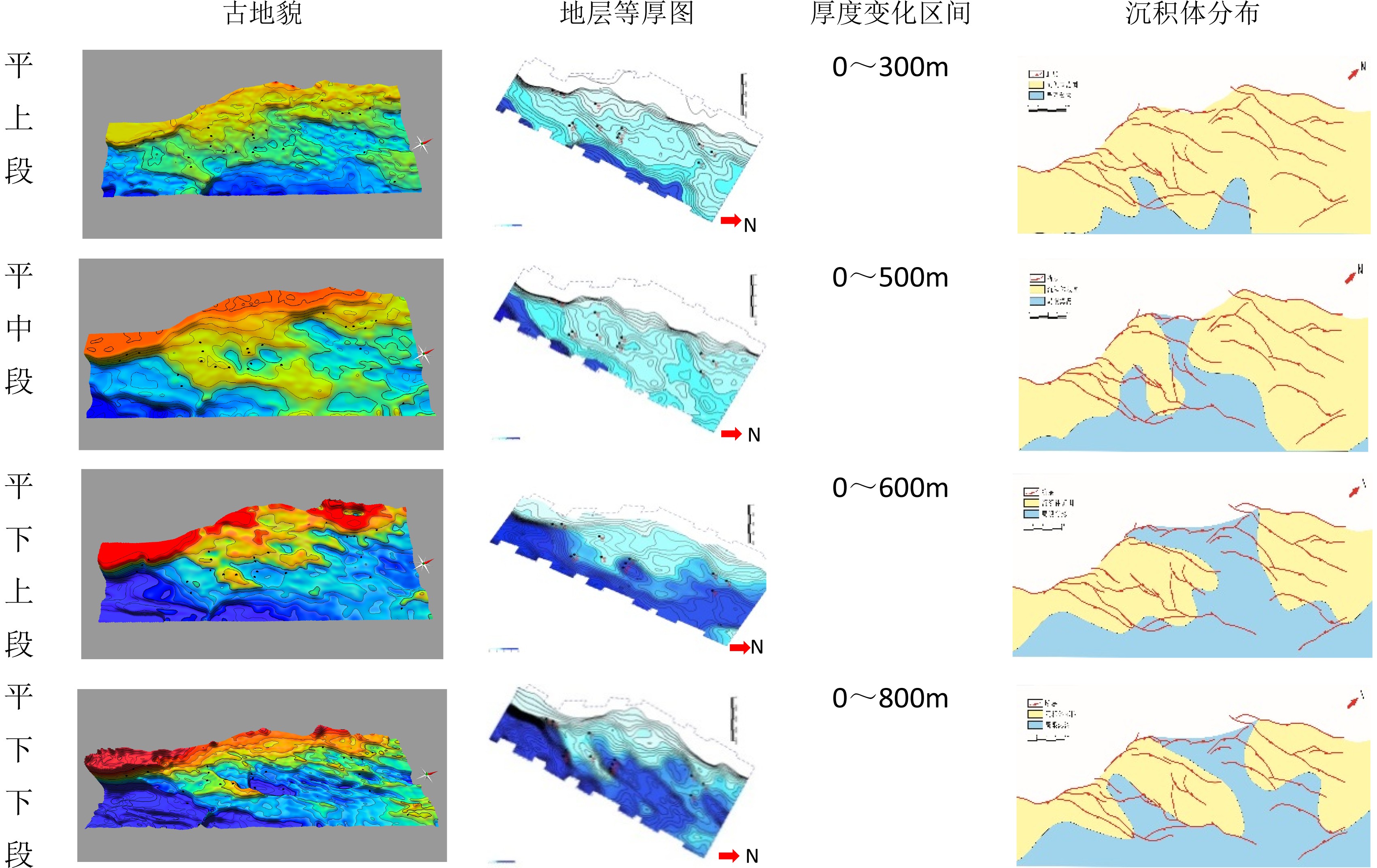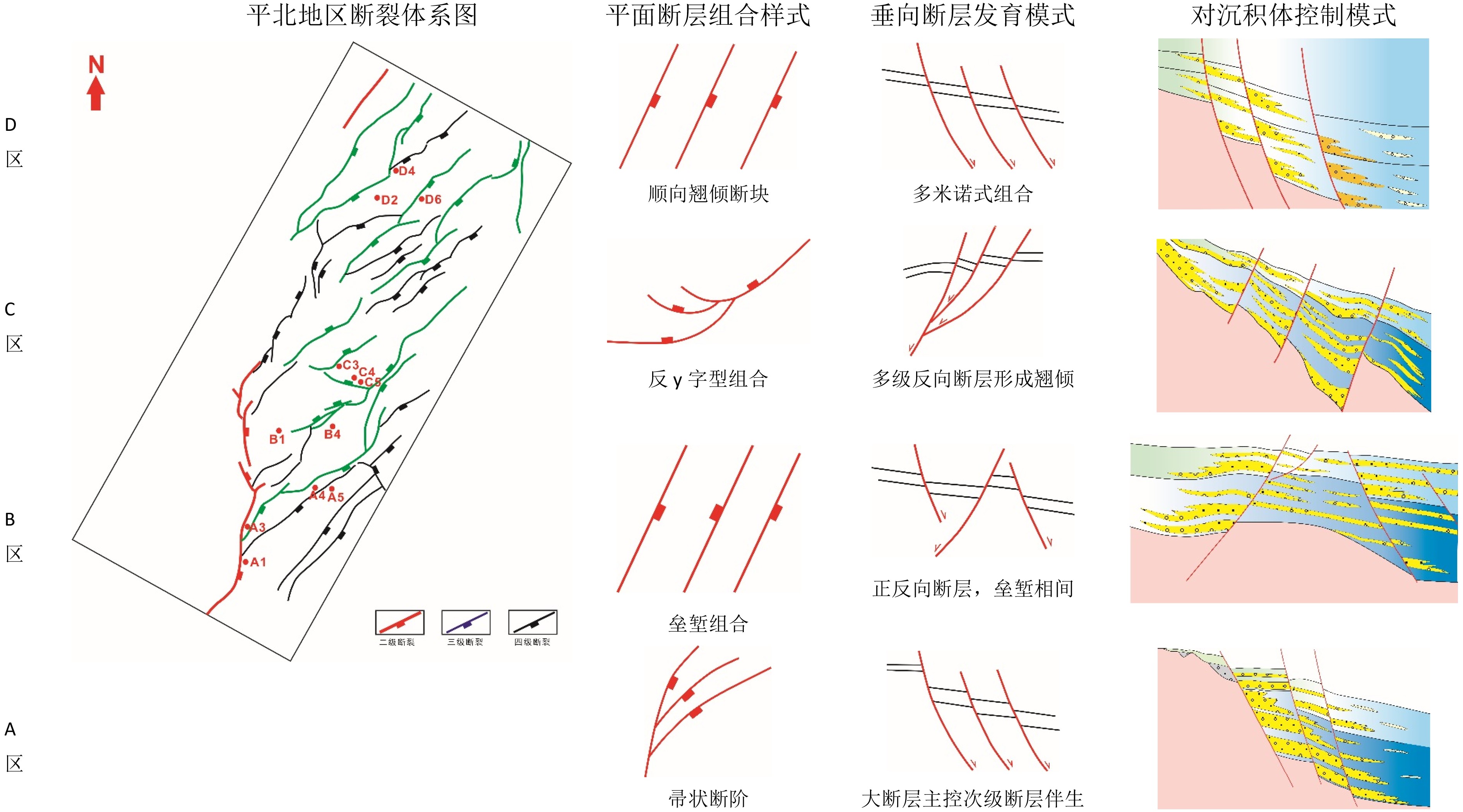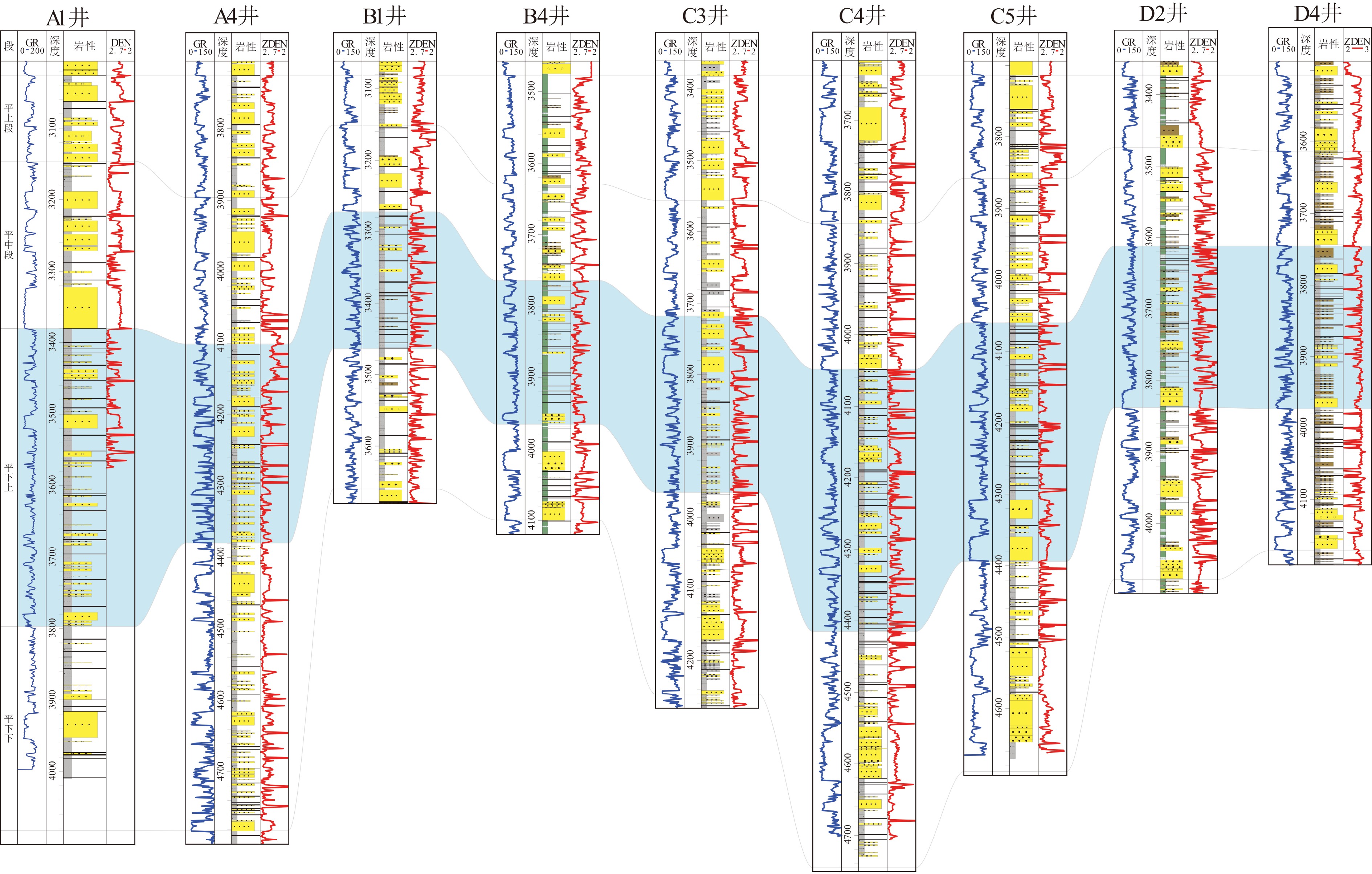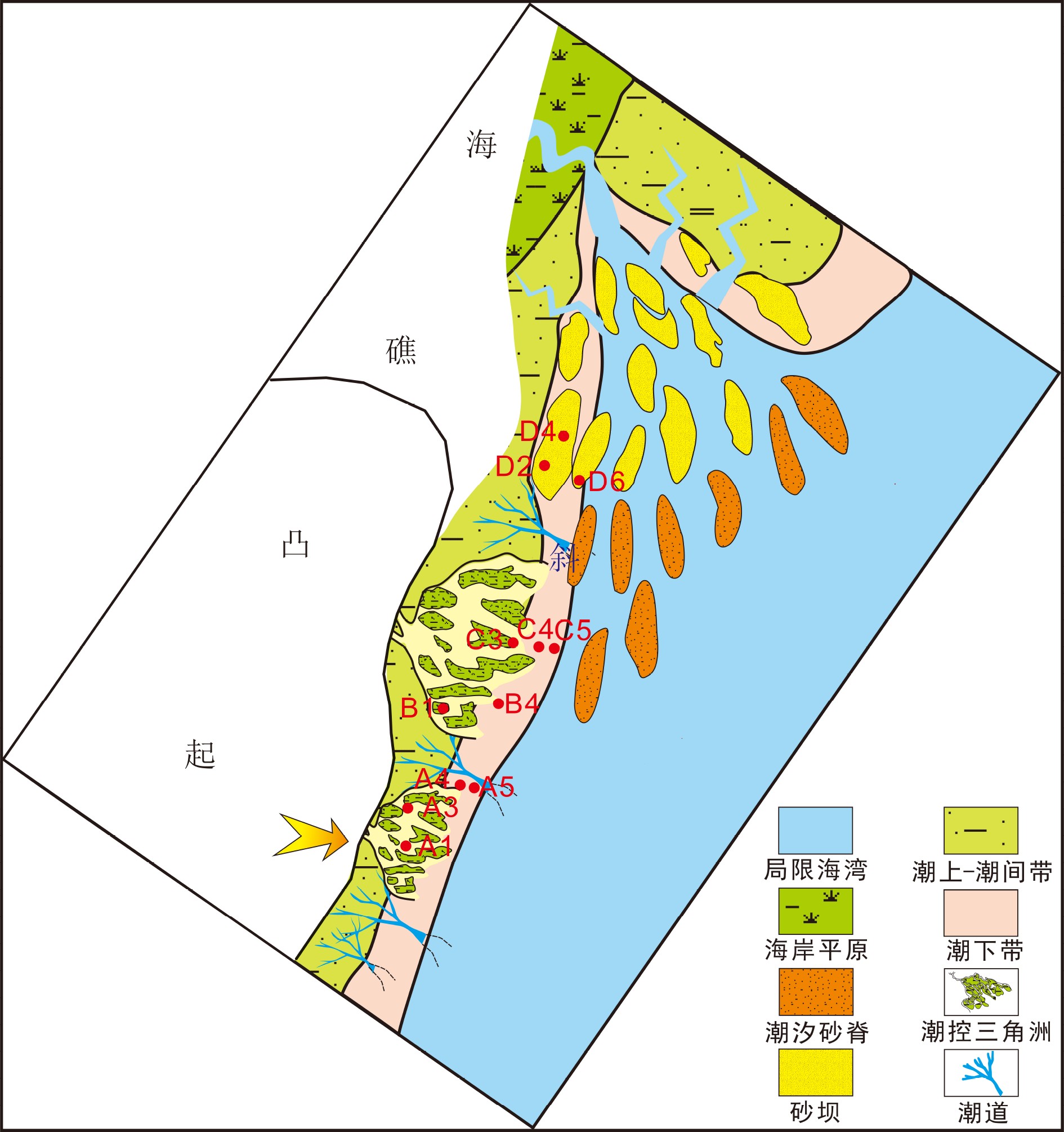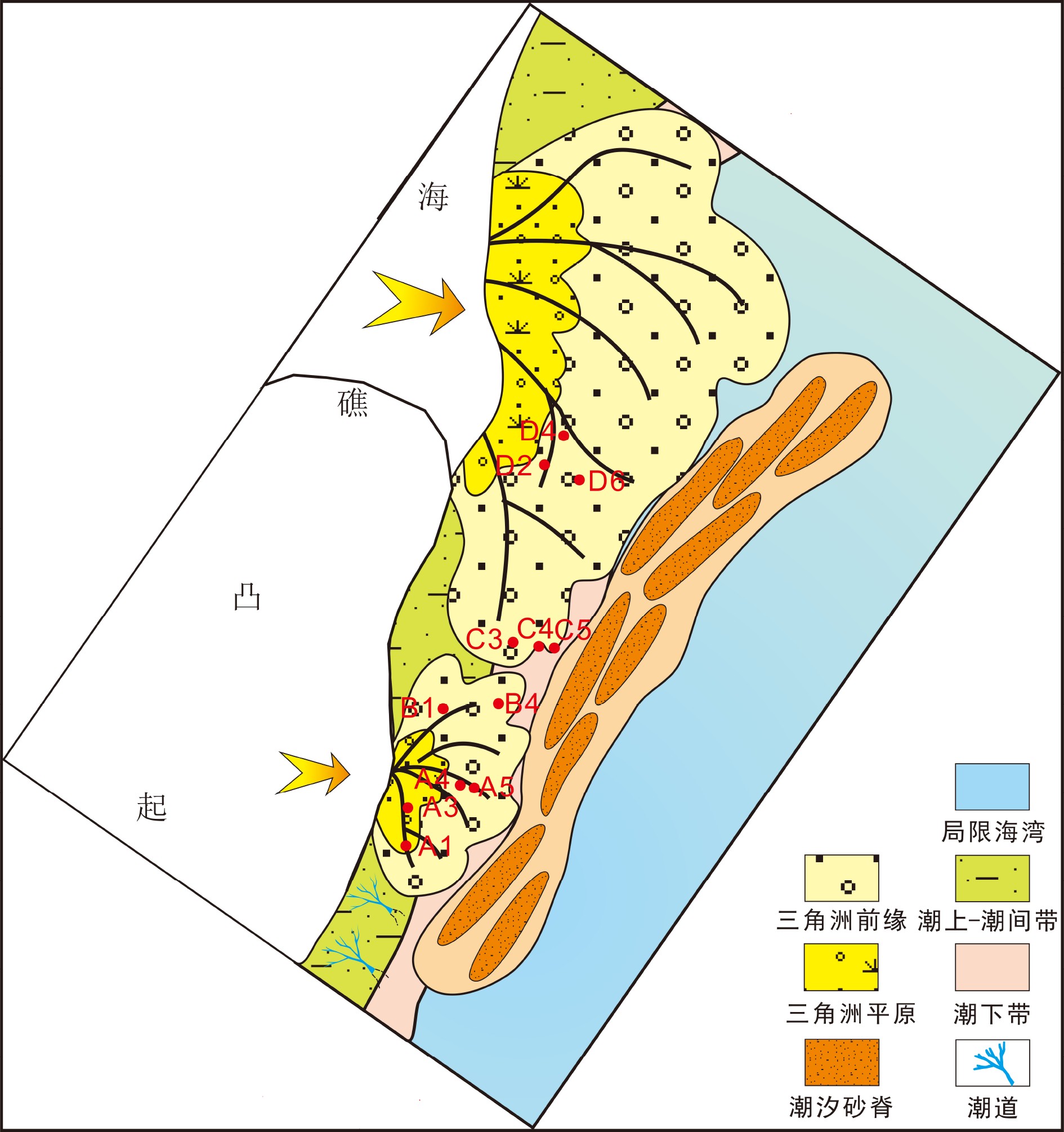“Multi–factor control of sandboies distribution”in the Pinghu Formation, Pingbei region of Baochu slop, the Xihu Sag
-
摘要: 随着勘探开发程度的不断升高,西湖凹陷保俶斜坡带平北地区中上始新统平湖组构造―岩性复合油气藏显示出较大的勘探潜力。然而,该区构造―岩性复合油气藏勘探基础薄弱,加之构造、沉积条件复杂,砂体展布规律不清,阻碍了该区的勘探进程。本文基于三维地震及钻井等资料,从构造、层序及沉积3个方面对砂体分布的控制因素进行分析,认为构造古地貌及可容纳空间控制地层厚度及沉积体规模;同沉积断裂坡折带控制砂体的展布;体系域类型控制砂体的时空配置,沉积微相类型控制砂体的储集物性。综合分析控砂因素认为:断陷期的平下下段和平下上段是构造―岩性圈闭发育的主要层段,勘探方向为低位体系域控沉积断层下降盘的地势低洼汇砂区,而平中上段有利的岩性圈闭勘探区为三角洲前缘砂地比低或三角洲前端发育的潮汐砂脊带。Abstract: With the progress of hydrocarbon exploration and development, structural-lithologic reservoirs have become more and more significant. However, the exploration of the structural-lithologic reservoirs is not so successful owing to the complexity of the tectonic evolution of the region and the changes in related sedimentary conditions. The sand bodies’distribution boundaries and patterns are difficult to define and have always become the difficult problems to exploration. Based on the newly acquired 3D seismic and drilling data, this article analyzed the controlling factors on sand bodies from the viewpoints of structure, stratigraphic sequence and sedimentation. It is found that there are four factors to be considered: The paleotectonics, paleogeomorphology and accommodation spaces, which control the thickness of the strata and the spatial distribution of sand bodies; the syn-depositional faulting slope break belt which restricted the lateral extension of sand bodies; the sequence patterns and system tracts, which control the spatial and temporal framework of sand bodies; and the types of sedimentary microfacies which determines the reservoir physical properties. The Lower Pinghu Formation was deposited in an intensive faulting period, in which there developed plenty of structural - lithologic traps, which are always been found in the low-lying areas of the downthrow block of syn-depositional fault. However the favorable structural-lithologic traps in the upper-middle Pinghu Formation may occur in the delta front deposits and tidal ridge sandbodies.
-
平北地区面积近1 800 km2(图1),自1988年钻探宝云亭1井以来,经过30年的勘探开发,已建成投产3个油气田,主要勘探目的层为中上始新统平湖组。勘探初期由于缺少三维地震资料,多利用二维地震测线开展工作,主要以勘探构造油气藏为主,预探井多布署在构造高点。随着三维地震资料覆盖率的增加,勘探及开发工作的不断深入,发现部分已钻的构造圈闭不落实,圈闭无效,钻遇的气藏为构造―岩性复合气藏;同时3个气田的多口开发井也证实,砂体在平面上连续性差,气藏多受构造和岩性双重因素控制,因此,平北地区构造―岩性复合圈闭具有较大的勘探潜力。平北地区剩余构造圈闭数量少,条件差,资源规模小,可钻探性低,截止目前,平北地区探井密度约为0.017口/km2,勘探程度低,勘探潜力大,因此,构造―岩性复合圈闭、岩性圈闭应为下一步的主要勘探方向。
对于断陷期构造―岩性复合圈闭的勘探而言,砂体的展布范围不仅控制了圈闭规模的大小,更从根本上决定了圈闭是否存在,因此,弄清砂体的展布形态至关重要。前人研究表明,砂体的分布及富集受多重地质因素的控制。贾承造等认为盆地的构造运动、古气候变迁、古物源等因素控制了砂体形成和分布[1];李丕龙等认为陆相断陷盆地不同断裂形成的断阶、段坡或断裂坡折带等对砂体发育与分布起着重要的控制作用[2];邹才能等提出陆相断陷盆地内砂体分布主要受控于斜坡、断裂和水深3个重要因素[3];冯有良提出层序界面控制了地层油气藏的发育,盆缘的沟谷和构造坡折带控制的层序低位体系域和高位体系域砂体是岩性油气藏的主要储集体[4]。赵贤正等以二连盆地为例,认为砂体的展布主要受到构造带类型、同沉积断层组合样式、体系域类型、坡折带类型及沉积相类型的控制[5-6]。
通过对西湖凹陷保俶斜坡带平北地区砂体的形成和分布的研究认为该区为缓坡背景,砂体分布主要受到构造古地貌、坡折带类型、层序样式及沉积微相类型的控制。
1. 构造古地貌及可容纳空间控制地层厚度及沉积体规模
西湖凹陷自西向东可以划分为保俶斜坡带、三潭深凹带、中央背斜带、白堤深凹带及天屏断阶带5个次级构造单元。平北地区位于保俶斜坡带中段,总体上呈西南高、北东低的斜坡。主力勘探目的层中上始新统平湖组为一个从水进到水退的过程[7],从下至上可划分为平下段、平中段及平上段3个段,平下段可进一步划分为平下下、平下上2个亚段。
平湖组早期继承了基底先存古地貌,自南向北发育宝云亭、武云亭、孔雀亭3个古鼻隆,具有隆洼相间的地貌格局,西部海礁凸起长期遭受剥蚀,为主要物源区,沉积物通过古地貌沟谷、断槽物源通道大量卸载于具有较大可容纳空间的古地貌低洼区,造成古隆起上下地层厚度差别大,在古地貌低洼区可达800 m以上,斜坡大部分地区为200~300 m(图2)。同时,受古地貌限制,沉积体及砂体展布范围较局限。
平下上段,构造活动及古地貌分隔性有所减弱,但该时期古地貌依然是沉积体发育的主要控制因素,地层厚度为0~600 m,沉积物仍主要卸载于古地貌低势区(图2)。同时,该期为平湖组最大海泛期,A/S比较高,整体上沉积体及砂体规模较小,但也不乏局部古地貌低洼处较厚砂体富集。例如C5井,在平下段单层厚度>30 m,累计储层厚度>70 m的砂层。
平中段进入断拗转换阶段,构造活动大幅减弱,随着海进到海退的转换,整个斜坡以填平补齐作用为主,地层展布范围大,厚度更加均衡,沉积体规模增大(图2),以向海方向进积的三角洲为主,砂体分布范围更大,连续性更好。
平上段平北地区形成一个宽缓的斜坡,构造古地貌对沉积体控制作用基本消失,沉积类型以规模较平中段更大的三角洲为主,地层厚度为0~300 m,厚度差进一步减小(图2),砂体更加发育,连续性增强。
2. 同沉积断裂坡折带控制砂体的展布
长期活动的同沉积断裂形成的“构造坡折带”制约着盆地充填可容纳空间的变化,控制着低水位体系域、高水位体系域三角洲―岸线体系的发育部位,对沉积体系的发育和砂体分布起重要的控制作用[8-10]。平湖组沉积于中―晚始新世断陷―断拗转换期,断裂活动对砂体的发育展布具有较强的控制作用,尤其是断层活动较强的平下下段及平下上段。
平北地区发育二级―五级断裂,其中三级及以上断裂组成的断裂坡折带对沉积及砂体具有明显的控制作用。在始新世持续性北西―南东方向扭张力作用下形成一系列NE―SW走向的断裂体系(图3)。同时,受控于先存古地貌,平北地区自南向北发育4种断裂系统组合样式。
2.1 帚状断阶断裂坡折带及砂体分布样式
帚状断裂坡折带见于A区,以发育一条控凹的二级边界主断裂为特征,垂向断距最大可达4 000 m,主断裂北部末端呈帚状撒开,分枝成若干条三级―四级次级伴生断裂,其中三级断裂的平面延伸长度约10 km,垂向断距约1 000 m,对沉积及砂体的展布具有较强的控制作用。四级断裂垂向断距约500 m,对砂体的控制作用较小。这种断裂的形成一般与凹陷走滑作用有关。帚状断裂坡折带对沉积体及砂体的控制作用主要表现为主干断裂捕获其上升盘水系,控制碎屑体系向凹陷内的推进方向,主干断裂的延伸方向及发散部位控制着沉积中心及砂体分布。在主干断裂主体部位下降盘或内叉角的构造低部位砂体厚度较大,形成“断角砂体”。该区位于主干断裂下降盘的A3井平下段均发育厚层砂体。而帚状末端四级断裂控制的A5井砂体则欠发育(图3)。
2.2 垒堑组合断裂坡折带及砂体分布样式
垒堑组合型断裂坡折带发育于B区、C区。这种断裂坡折带的主要特征为发育2组相对倾向的断裂,平面上与斜坡倾向相同的顺向断裂(B区)呈平行式展布,多为三级断裂,与斜坡倾向相反的反向断裂(C区)多为反“y”字型组合,垂向上形成多个反向翘倾的半地堑构造。这种断裂坡折带组合的发育与宝云亭古隆鼻的有关。垒堑相间型断裂坡折带对沉积及砂体的控制作用主要体现在反向大断裂捕获其上游的沉积体,使沉积物沿限定型地堑的大断裂根部向前推进,垂直于断裂,沿翘倾方向砂体逐渐减薄尖灭。每个三级反向断裂控制一个半地堑,形成一个沉积中心(图3)。C5井靠近反向断裂根部,平下段发育多层厚层砂体,向翘倾方向C4井砂体逐渐减薄,而位于翘倾端的C3井砂体已尖灭,发育泥岩。而地垒上砂体整体发育欠佳,较厚层的砂体主要发育于古隆起上的次级低洼区。
2.3 顺向翘倾断块断裂坡折带及砂体分布样式
顺向翘倾断块型断裂坡折带主要发育于D区,以伸展构造样式为主。平面上2~3条NE―SW走向的三级弧形断裂形成一个控沉积坡折带,由斜坡高部位到低部位发育4个断裂坡折带,垂向上由坡折带形成逐级下掉的顺向翘倾断块。顺向翘倾断块断裂坡折带对沉积的控制作用一方面体现在两条断层相交处容易形成沉积物输送通道,另一方面,沉积体垂直于断层走向上沿断阶逐级沉积,由于翘倾作用,断层根部具有相对较大的可容空间,形成较厚砂体堆积(图3)。D区的8口钻井均钻探在靠近断层根部处,均在平下段钻遇较厚砂体。
3. 体系域类型控制砂体的时空配置
据经典层序地层学原理,可将一套完整的层序运用三分法划分出低位体系域、海侵体系域和高位体系域。体系域的形成与可容空间变化有着十分密切的联系,随着可容空间的变化,不同类型体系域控制了各沉积体系砂体的形成与分布[11-15]。西湖凹陷始新统平湖组为一个完整的二级层序。在二级层序格架内划分了低位体系域平下下段,海侵体系域平下上段及高位体系域平中―上段。
3.1 低位体系域(LST)
低位体系域(LST)期,基准面上升缓慢,沉积物供给速率大于可容空间增加速率,通常情况下以发育富砂质的扇三角洲、辫状河三角洲沉积。平北地区低位体系域发育时期受到强烈的断陷作用及古地貌格局的限制,发育近物源,限定型的潮控三角洲沉积(图2)。钻井揭示平下下段的厚层砂岩发育,多为中粗砂岩,常含砾,测井曲线多呈箱型,具有正旋回。砂地比为30%~50%(图5),研究认为:当地层砂地比>60%,发育构造圈闭,砂地比<30%发育岩性圈闭,介于两者中间的多发育构造―岩性复合圈闭[6]。因此,就沉积序列而言,平下段适合构造―岩性复合圈闭的发育,同时,其上覆的平下上段大规模海侵泥岩也具备形成区域性盖层的条件,具备很好的储盖组合匹配条件(图4,图5)。而目前,平北地区平下下多口钻井均揭示构造―岩性复合圈闭,直接证明平下下段具备发育复合圈闭的地质条件。
3.2 海侵体系域(TST)
海侵体系域(TST),基准面快速上升,沉积物供给速率远小于新增可容空间速率,通常易形成退积型近岸水下扇砂体。平北地区海侵体系域发育时期,断陷作用逐渐趋弱,但海平面快速的上升仍然使可容空间增加速率远大于沉积物供给速率。沉积体快速向陆方向退积,虽然仍发育受古地貌限定型的辫状河三角洲沉积,但沉积体规模缩小。钻井揭示平下上段地层具有“泥包砂”的特征,大多数钻井泥地比在70%以上,是一套泥岩厚度大,横向分布稳定,具有一定可对比性的区域性盖层(图4)。只在局部断层“聚砂”作用强烈处见具有一定厚度的砂岩发育。这种沉积建造对于岩性圈闭的发育提供很好的条件,孤立的砂岩被泥岩包裹,具有很好的生排烃条件及封堵条件。同时由于泥岩生烃等作用容易在砂岩中形成高压,对储层物性起到较好的保护作用。C区的C5井在平下上段钻遇的这类气藏物性好,产量高(图4)。
3.3 高位体系域(HST)
在高水位时期,受气候、构造及外部水系等因素影响基准面呈高频率的变化,沉积物供给速率等于或大于新增可容空间速率,通常发育加积型或进积型扇三角洲砂体。平中―上段西湖凹陷进入断拗转换阶段,构造趋于稳定,平北地区发育填平补齐的沉积作用,发育规模较大的受潮汐影响三角洲沉积。钻井揭示平上段砂体层数多,厚度大,砂地比最高可达80%,砂体横向连续性变好(图5)。在较高的砂地比条件下,不利于岩性圈闭的形成,侧向需要依靠断层形成封堵。同时,平湖组高位体系域上覆为渐新统花港组低位域富砂沉积,缺乏区域性泥岩盖层,不利于油气藏的保存,对于岩性圈闭的勘探应主要关注三角洲前缘砂地比降低至60%以下的地区。
4. 沉积相带控制砂体的储层物性
盆地的构造、沉积背景决定其沉积体系的形成和展布,不同类型沉积相对砂体的储集特征具有重要的控制作用,不同类型砂体的沉积构造、沉积韵律、厚度、岩性储集特征都存在着差异[16]。西湖凹陷平湖组具有局限海湾的沉积背景,发育辫状河三角洲―潮坪共生沉积体系。
平下下及平下上段,断陷作用形成较大的可容空间,在河流及轴向潮流的作用下发育潮控三角洲及河口湾沉积,河口湾前端发育放射状湾口型砂脊(图6)。砂体类型有三角洲前缘分流河道砂、潮道砂、潮坪砂、河口湾砂坝砂及潮汐砂脊砂。在潮汐能量较强的水动力环境下,三角洲前缘水下分流河道与潮道常具有相似的岩电特征,难以区分,统称为水道。目前,平北地区钻井已证实具有良好储集性能的砂体类型有:水道砂及河口湾砂坝砂。水道砂单层厚度一般为20~70 m,岩性以浅灰色中―粗砂岩为主,底部多含砾,测井曲线多呈微齿化箱型或钟型,岩心多见强水动力作用形成的板状交错层理、底砾及侵蚀面等(表1)。在埋深4 000 m以下仍保留部分原生孔隙,平均孔隙度为12.5%,平均渗透率可达5 mD。是平北地区深层优质的储层。河口湾砂坝主要发育在平北北部地区,钻井上单层厚度为10~30 m,以浅灰色细―粗砂岩为主(表1),偶含砾,测井曲线呈微齿化箱型或钟型,岩心上以较强水流形成的板状和平行层理为主。这类砂体由于受到潮汐水流的反复淘洗,成熟度高,抗压实能力强,在埋深大于4 100 m时仍保留部分原生孔隙,并常见溶孔和铸模孔。孔隙度为10%~20%,渗透率约为0.49~145 mD,平面上具有较强的非均质性。
表 1 平北地区不同类型砂体特征Table 1. The characteristics of different sandbodies in Pingbei region砂体类型 平下段 平中-上段 水道 河口湾砂坝 水下分流河道 单砂厚 20~70m 10~30m 10~40m 颜色 浅灰、灰白 浅灰、灰白 浅灰、灰白 岩性 砂岩 砂岩 砂岩 粒度 中-粗砂,含砾 细-粗砂,偶含砾 细砂-砾岩 岩电特征 


沉积构造 


孔隙度(%) 9.9~15(12.5) 9~19.56(13.77) 8~22.23(13.12) 渗透率(mD) 0.5~31.6(5.1) 0.49~145(21.88) 1~227(35.98) 平中―上段斜坡区构造稳定,断层活动微弱或停止活动,填平补齐及持续性海退,海湾内主要以平行岸线的潮流作用为主,沉积体以规模逐渐增大的受潮汐影响的非对称三角洲为主,三角洲逐渐向凹陷中央推进,三角洲前端发育受潮汐改造形成的与岸线斜交的潮汐砂脊(图7)。储集条件较好的砂体类型主要有三角洲前缘水下分流河道砂、潮汐砂脊砂。钻井揭示的三角洲前缘水下分流河道砂岩厚度多为30 m,岩性以浅灰色细砂岩―砾岩为主,测井曲线呈微齿化箱型,岩心上可见圆―次圆状的砾石定向排列及板状交错层理等反应牵引流沉积构造(表1)。水下分流河道砂岩在4 200 m埋深下仍保持部分原生孔隙,孔隙度多在10%以上,渗透率多大于1 mD,为平中上段有利储层。同时,砂脊砂目前虽未有钻井揭示,但从成因上,潮汐砂脊是三角洲前缘砂体经过潮汐等较强水流改造形成的,砂岩通常具有厚度大,成熟度高,抗压实能力强的特征,推测应具有较好的储层物性。并且潮汐砂脊常成群成带分布,易形成叠合连片的规模储量,是优质的勘探目标。
5. 结论
(1)平北地区砂体的发育及展布受古地貌及可容纳空间、同沉积断裂破折带、体系域类型以及沉积相类型多重因素控制。
(2)古地貌及可容纳空间从宏观上控制了地层厚度及沉积体规模,在此基础上由同沉积断裂坡折带及体系域类型具体控制了砂体的展布和时空配置关系,而沉积相类型控制了砂体的储集物性。
(3)平北地区平湖组平下下及平下上段是构造―岩性圈闭发育的主要层段,勘探方向为低位体系域控沉积断层下降盘的地势低洼汇砂区,而平中上段砂岩相对更发育,有利的岩性圈闭勘探区为三角洲前缘砂地比低或三角洲前端发育的潮汐砂脊带。
-
表 1 平北地区不同类型砂体特征
Table 1 The characteristics of different sandbodies in Pingbei region
砂体类型 平下段 平中-上段 水道 河口湾砂坝 水下分流河道 单砂厚 20~70m 10~30m 10~40m 颜色 浅灰、灰白 浅灰、灰白 浅灰、灰白 岩性 砂岩 砂岩 砂岩 粒度 中-粗砂,含砾 细-粗砂,偶含砾 细砂-砾岩 岩电特征 


沉积构造 


孔隙度(%) 9.9~15(12.5) 9~19.56(13.77) 8~22.23(13.12) 渗透率(mD) 0.5~31.6(5.1) 0.49~145(21.88) 1~227(35.98) -
[1] 贾承造, 池英柳. 中国岩性地层油气藏资源潜力与勘探技术: 隐蔽油气藏形成机理与勘探实践[M]. 北京: 石油工业出版社, 2004: 15-25. JIA Chengzao, CHI Yingliu. Resource Potential and Exploration Techniques of Stratigraphic and subtle Reservoirs in China: Formation Mechanism and Exploration Practice of Subtle Pool[M]. Beijing: Petroleum Industry Press, 2004: 15-25.
[2] 贾承造, 赵文智, 邹才能, 等. 岩性地层油气藏形成条件与分布规律[M]. 北京: 石油工业出版社, 2004: 100-109. JIA Chengzao, ZHAO Wenzhi, ZOU Caineng, et al. Formation Conditions and Distribution of Lithogic Stratigraphic Reservoirs[M]. Beijing: Petroleum Industry Press, 2004: 100-109.
[3] 李丕龙, 庞雄奇. 陆相断陷盆地隐蔽油气藏形成-以济阳坳陷为例[M]. 北京: 石油工业出版社, 2004. LI Pilong, PANG Xiongqi. The Formation of Subtle Reservoirs in Continental Fault-Depression Basins-Take Jiyang Depression as an Example[M]. Beijing: Petroleum Industry Press, 2004.
[4] 赵贤正, 金凤鸣, 刘震, 等. 二连盆地地层岩性油藏" 多元控砂-四元成藏-主元富集”与勘探实践(Ⅰ)-" 多元控砂”机理[J]. 岩性油气藏, 2007, 6(2):9-15. [ZHAO Xianzheng, JIN Fengming, LIU Zhen, et al. " Multi-factor controlling, four-factor entrapping and key-factor enrichment” of stratigraphic-lithologic reservoirs and exploration practice in Erlian basin(Ⅰ)-" Multi-factor controlling” mechanism [J]. Lithologic Reservoirs, 2007, 6(2): 9-15. doi: 10.3969/j.issn.1673-8926.2007.02.002 [5] 赵贤正, 蒲秀刚, 王家豪, 等. 断陷盆地缓坡区控砂控藏机制与勘探发现-以歧口凹陷歧北缓坡带为例[J]. 石油学报, 2017, 38(7):729-739. [ZHAO Xianzheng, PU Xiugang, WANG Jiahao, et al. Sand and reservoir controlling mechanism and exploration discovery in the gentle slope of fault basin: a case study of Qibei slope in Qikou Sag [J]. Acta Petrolei Sinica, 2017, 38(7): 729-739. doi: 10.7623/syxb201707001 [6] 韩春元, 赵贤正, 金凤鸣, 等. 二连盆地地层岩性油藏" 多元控砂-四元成藏-主元富集”与勘探实践(Ⅳ)-勘探实践[J]. 岩性油气藏, 2008, 20(1):15-20. [HAN Chunyuan, ZHAO Xianzheng, JIN Fengming, et al. Multi-factor controlling, four-factor entrapping and key-factor enrichment of stratigraphic-lithologic reservoirs and exploration practice in Erlian basin(Ⅳ)-Exploration practice [J]. Lithologic Reservoirs, 2008, 20(1): 15-20. doi: 10.3969/j.issn.1673-8926.2008.01.003 [7] 李磊, 王小刚, 陈玲玲, 等. 东海西湖凹陷始新统复合潮汐水道三维地震表征[J]. 天然气地球科学, 2015, 26(2):352-359. [LI Lei, WANG Xiaogang, CHEN Lingling, et al. 3-D seismic characterization of the Eocene complex tidal channels in Xihu Sag, East China Sea [J]. Natural Gas Geoscience, 2015, 26(2): 352-359. [8] 林畅松, 潘元林, 肖建新, 等. " 构造坡折带”-断陷盆地层序分析和油气预测的重要概念[J]. 地球科学-中国地质大学学报, 2000, 25(3):260-266. [LIN Changsong, PAN Yuanlin, XIAO Jianxin, et al. Structural slope-break zone: key concept for stratigraphic sequence analysis and petroleum forecasting in fault subsidence basins [J]. Earth Science-Journal of China University of Geoscience, 2000, 25(3): 260-266. doi: 10.3321/j.issn:1000-2383.2000.03.008 [9] 王英民, 金武弟, 刘书会, 等. 断陷湖盆多级坡折带的成因类型、展布及其勘探意义[J]. 石油与天然气地质, 2003, 24(3):199-203, 214. [WANG Yingmin, JIN Wudi, LIU Shuhui, et al. Genetic types, distribution and exploration significance of multistage slope breaks in rift lacustrine basin [J]. Oil & Gas Geology, 2003, 24(3): 199-203, 214. doi: 10.3321/j.issn:0253-9985.2003.03.002 [10] 肖焕钦, 王宝言, 陈宝宁, 等. 济阳坳陷陡坡带断裂控砂模式[J]. 油气地质与采收率, 2002, 9(5):20-23. [XIAO Huanqin, WANG Baoyan, CHEN Baoning, et al. Fracture sand control pattern in actic region of Jiyang Depression [J]. Petroleum Geology and Recovery Efficiency, 2002, 9(5): 20-23. doi: 10.3969/j.issn.1009-9603.2002.05.007 [11] 赵贤正, 卢学军, 崔周旗, 等. 断陷盆地斜坡带精细层序地层研究与勘探成效[J]. 地学前缘, 2012, 19(1):10-19. [ZHAO Xianzheng, LU Xuejun, CUI Zhouqi, et al. Detailed research of fine sequence stratigraphy and exploration results in the slope zone of faulted basin [J]. Earth Science Frontiers, 2012, 19(1): 10-19. [12] 陈贤良, 樊太亮, 王宏语, 等. 松辽盆地梨树断陷层序结构特征及岩性地层圈闭[J]. 地层学杂志, 2016, 40(3):308-317. [CHEN Xianliang, FAN Tailiang, WANG Hongyu, et al. Sequence structures and lithologic-stratigraphic traps in the Lishu rift, Songliao Basin [J]. Journal of Stratigraphy, 2016, 40(3): 308-317. [13] 邹才能, 陶士振, 古志东. 陆相坳陷盆地层序地层格架下岩性地层圈闭/油藏类型与分布规律-以松辽盆地白垩系泉头组-嫩江组为例[J]. 地质科学, 2006, 41(4):711-719. [ZOU Caineng, TAO Shizhen, GU Zhidong. Types and distributions of litho-stratigraphic traps/reservoirs in sequence stratigraphic framework in continental depressional basin: an example from the Cretaceous in the Songliao basin [J]. Chinese Journal of Geology, 2006, 41(4): 711-719. doi: 10.3321/j.issn:0563-5020.2006.04.014 [14] 曹颖辉, 迟柳英, 薛良清, 等. 沉积基准面在层序划分对比及地层岩性油气藏预测中的应用[J]. 石油实验地质, 2002, 24(1):36-47. [CAO Yinghui, CHI Liuying, XUE Liangqing, et al. Application of depositional base-level concept in sequence stratigraphic division, correlation and litho-stratigraphic traps prediction [J]. Petroleum Geology & Experiment, 2002, 24(1): 36-47. doi: 10.3969/j.issn.1001-6112.2002.01.006 [15] 郭少斌. 陆相断陷盆地层序类型及隐蔽圈闭预测[J]. 地质科技情报, 2006, 25(5):15-20. [GUO Shaobin. Sequence types and subtle reservoirs exploration in continental rift-subsidence basin [J]. Geological Science and Technology Information, 2006, 25(5): 15-20. doi: 10.3969/j.issn.1000-7849.2006.05.003 [16] Abbas A, Zhu H T, Zeng Z W, et al. Sedimentary facies analysis using sequence stratigraphy and seismic sedimentology in the Paleogene Pinghu Formation, Xihu Depression, East China Sea Shelf Basin [J]. Marine and Petroleum Geology, 2018, 93: 287-297. doi: 10.1016/j.marpetgeo.2018.03.017
-
期刊类型引用(9)
1. 屈童,黄志龙,李天军,杨易卓,王柏然,王瑞. 西湖凹陷平北地区武云亭凝析气田形成条件与成藏特征. 地质学报. 2024(01): 247-265 .  百度学术
百度学术
2. 俞伟哲,胡伟. 中深层天然气分流河道型储层逐级刻画技术研究与应用. 低碳世界. 2024(05): 28-30 .  百度学术
百度学术
3. 覃军,熊萍,何新建,沈冠华,王瑞霞,梅廉夫,吕志欢,叶青. 东海盆地石门潭组属于裂陷期地层序列吗?. 地层学杂志. 2024(04): 380-391 .  百度学术
百度学术
4. 李倩,李昆,庄建建,陈子健,王丹萍,王修平,晏玉环,刘名杨. 西湖凹陷西斜坡断层—岩性圈闭形成条件探讨. 海洋石油. 2022(02): 14-22+38 .  百度学术
百度学术
5. 周荔青,江东辉,周兴海,李昆,庄建建,刘闯. 东海西湖凹陷西斜坡断层—岩性油气藏富集评价体系与勘探方向. 石油实验地质. 2022(05): 747-754 .  百度学术
百度学术
6. 庄建建,李喆,巩兴会,万丽芬. 西湖凹陷WBT地区平湖组下段有利储层预测. 海洋石油. 2021(01): 8-14+21 .  百度学术
百度学术
7. 李斌,杨鹏程,蒋彦,陈现,李倩,李喆. 西湖凹陷西斜坡W构造异常高压特征及对油气成藏的影响. 海洋石油. 2021(02): 11-19+36 .  百度学术
百度学术
8. 江东辉,蒲仁海,苏思羽,范昌育,周锋,杨鹏程. 断陷盆地斜坡带大型油气田成藏条件——西湖凹陷平北缓坡断裂与岩性控藏有利区. 天然气工业. 2021(11): 33-42 .  百度学术
百度学术
9. 周荔青,江东辉,张尚虎,周兴海,杨鹏程,李昆. 东海西湖凹陷大中型油气田形成条件及勘探方向. 石油实验地质. 2020(05): 803-812 .  百度学术
百度学术
其他类型引用(2)



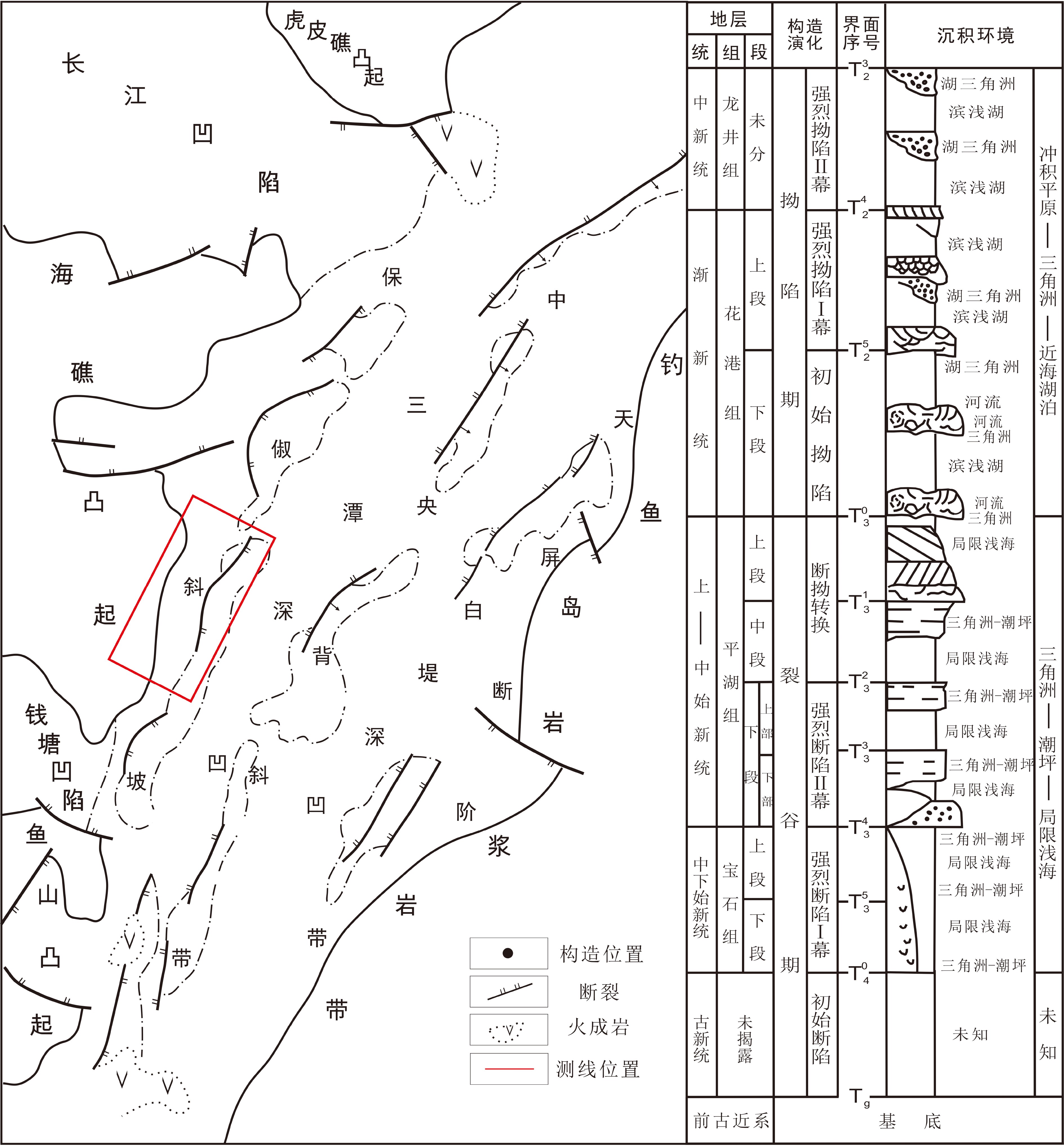
 下载:
下载:
